One of the best ways to get a closer look “under the hood” of public companies is to check out their Investor Day presentations.
Atlassian stand out as arguably one of the best of the platform bunch, having built a thriving app economy which has generated cumulative sales of over $500M+ to date (for apps sold through Atlassian’s marketplace). Selling half a billion dollars worth of apps built by other people to your existing customers isn’t easy to do.
Atlassian, however, really are on a tear.
Their most recent investor session helps explain why, and includes some trends and tales to learn from if you’re scaling a platform ecosystem, or evolving to become a platform economy.
TL;DR
- 3rd party apps/extensions are a core component of Atlassian’s land and expand strategy
- Apps and extensions, sold via Atlassian Marketplace, expand core platform functionality, which:
- expands the the utility value of Atlassian products for customers
- expands the stickiness of products, which leads to better retention for Atlassian
- Bonus: marketplace creates new revenue, helps Atlassian monetise freemium products
Teamwork is vital, and “integration” helps progress Atlassian’s vision/mission
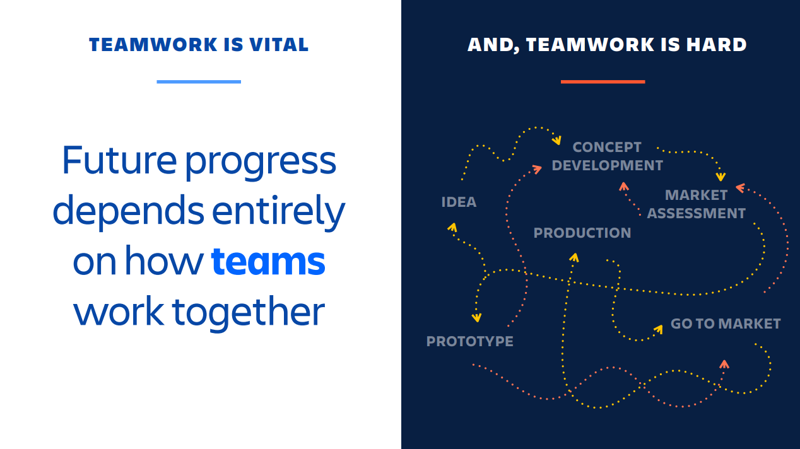
The first implicit nod to the value of developers/platform/apps/extensions/marketplace to Atlassian happens early on in the presentation (slide 16). Atlassian’s mission is to “unleash the potential of every team.” Atlassian then nod to the fact that teamwork is vital, and hard, with this:
“Future progress depends entirely on how teams work together.”
This vision statement implies an existing disconnect, which Atlassian can solve through providing interconnected products, applications, and workflows to their customers.
A strong ecosystem helps Atlassian win
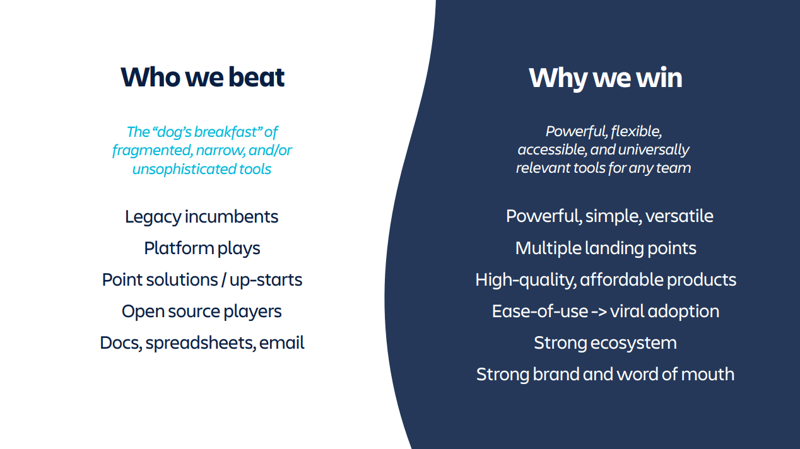
We’re still pretty early in the day/deck (slide 32) and Atlassian are already calling out their “strong ecosystem” as a core reason - one of six - as to “why we win.”
Notably, Atlassian look at “platform plays” as those who they beat, while talking up their “strong ecosystem” play. This is a solid observation from Atlassian - calling yourself a “platform” doesn’t create one, or create a defensible moat. “Platform plays” are a dime a dozen these days - and most companies following that path are really just building integrations into a small number of complementary products. They’re not building ecosystems. That’s much, much harder to do.
Once an ecosystem is created - however hard that might be - it is almost impossible to replicate, and arguably creates more compound customer value over time. This “moat” is a big reason why Atlassian are successful as they are, and a big reason why investors - and customers - love them.
Atlassian’s flywheel “rules” extend to their marketplace participants
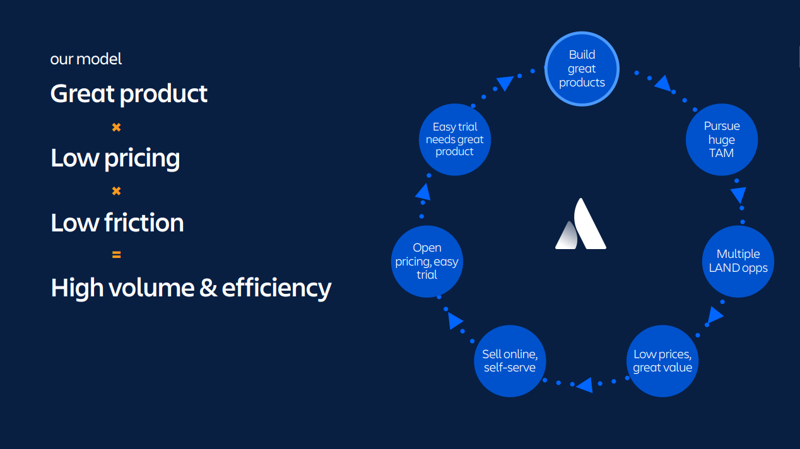
Slide 34 is the first (of many) references to Atlassian’s “flywheel” model. It’s a pretty simple formula:
Great product × Low pricing × Low friction = High volume & efficiency
Pretty simple (and familiar), right? Now that Atlassian have let us in on their flywheel methodology, they go a level deeper by sharing some “rules of play” they live by when taking their products to customers.
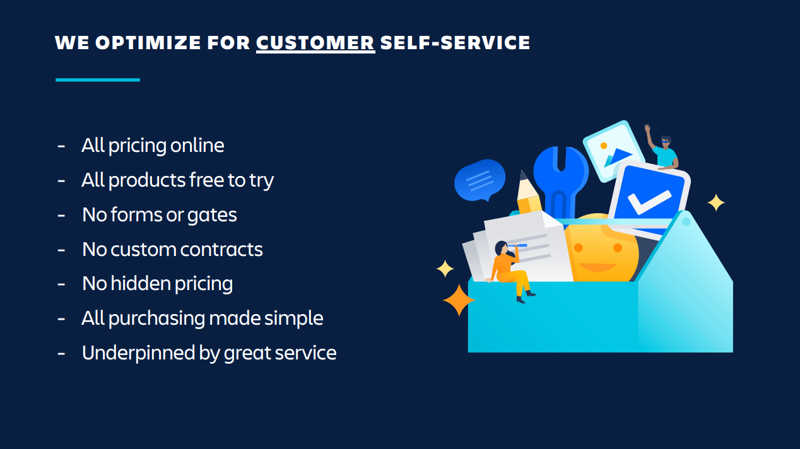
The “rules” Atlassian live by are pretty clear from slide 35. Atlassian optimize for customer self-service. They care a lot about - and optimise for - “getting out of the way” of customers, and providing enough information for those customers to evaluate and purchase products as quickly as possible. Great products matter. Informed choice matters, too. Great service also matters a lot.
What’s not stated in the deck or presentation - but I find super interesting - is that Atlassian believe in this methodology and framework not just for themselves, but for every developer of apps or extensions that wishes to sell those products through Atlassian’s marketplace.
A quick glance at Atlassian’s App approval guidelines mirrors the “rules” mentioned in the slide above. It’s a long list but here’s the first four things Atlassian care about:
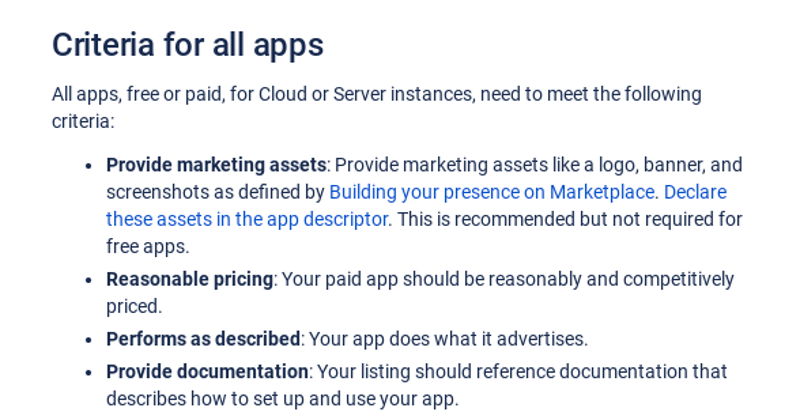
Atlassian require every participant in their marketplace optimize for customer self-service, just as they do.
Atlassian’s developer ecosystem is 50X the size of their “reseller” channel
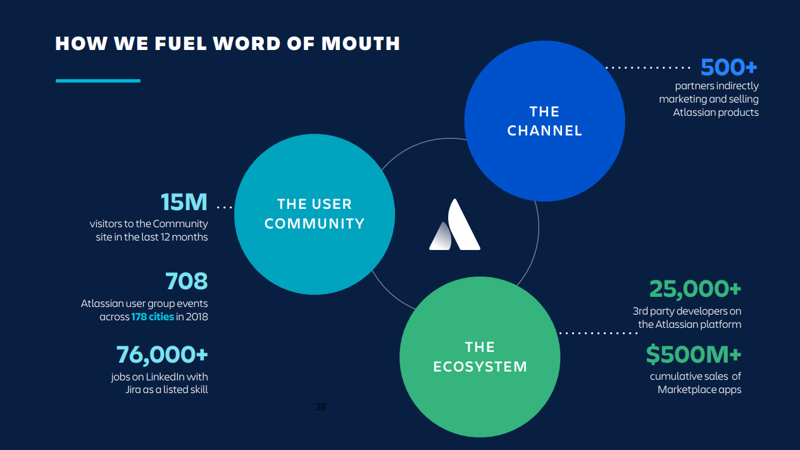
Globally, 500+ “channel” partners indirectly market or sell Atlassian’s products for them, but over 25,000 developers are active in Atlassian’s ecosystem. Building applications that can be bought through Atlassian’s marketplace, or creating bespoke solutions for Atlassian customers.
To put that in context: Atlassian today employ just over 3,000 people. With the addition of 3rd party developers, there are an additional 25,000+ brains focussed on extending Atlassian’s core product value for Atlassian customers. That’s a pretty sizeable extension to Atlassian’s product team, and gives them a huge amount of innovation leverage.
It’s a sizeable economy, too. Sales of marketplace apps to date has exceeded half a billion dollars. An annualised run-rate of over $100m was achieved FY2017, so it’s likely that half that $500M+ number was achieved over the past 24 months. A standalone business of its own.
Marketplace apps help Atlassian “land and expand”
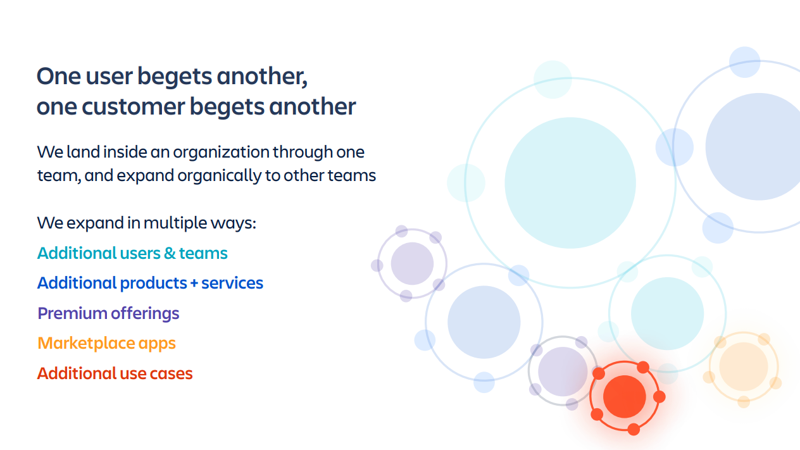
With a knowing nod back to earlier mentions of helping “teams work together,” marketplace apps are one of five ways in which Atlassian execute their land and expand strategy. This makes a lot of sense - it’s highly likely that multiple teams, across multiple business units, will be using multiple tools day-to-day.
For Atlassian to integrate their own products into that complicated set of tools, datasets, and workflows, requires a huge number of potential ways be “stitched in”. Apps and extensions built by 3rd party developers can help fill the gaps here across categories, verticals, etc.
Atlassian expand their core product value through these apps and extensions, which expands the core aggregate functionality of the Atlassian platform, which increases value and stickiness of Atlassian products.
This then opens up new conversations with customers about additional use cases, additional services, and more user/team licenses - which drives upgrades, adoption of new Atlassian products, and new marketplace apps. It really does keep the flywheel spinning.
Marketplace apps help customers adopt Atlassian during a “taking off” phase
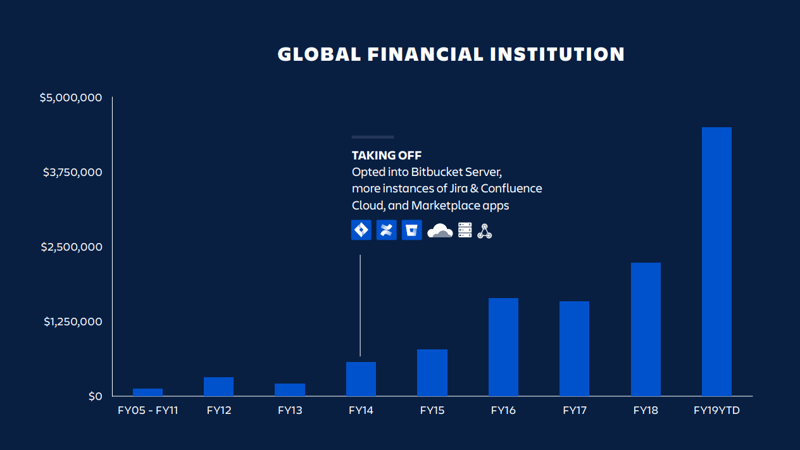
Later on in the day Jay Simons, Atlassian’s President walked through a customer case study (for a “Global Financial Institution) to help articulate how Atlassian implement their “land and expand” strategy.
Again, “marketplace apps” had a key part to play here, in particular during the “taking off” phase of customer growth. Jay mentioned that when customers start to install marketplace apps, it’s a signal to Atlassian that customers are growing and showing a deeper commitment Atlassian’s platform overall. And, likely a greater future investment in it.
Ecosystem extensibility is enabled by core platform commonality
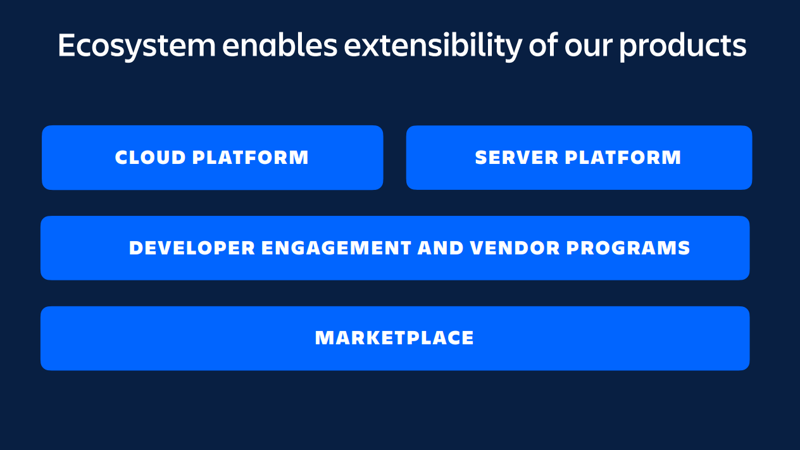
During his talk (slide 93), Atlassian CTO Sri Viswanath calls out yet again the value of their ecosystem and marketplace. It’s impossible for Atlassian to build all of the features that customers ask, and Atlassian are committed to enabling tens of thousands of developers to create customer value, and to sharing “the economic value” with them.
But this doesn’t happen without careful thought and planning - or without rationalizing Atlassian’s core platform to create commonality across their own products and services first. If Atlassian don’t build their own products and services in common, rationalized ways, how can they expect 3rd party developers to build high quality integrations common, rationalized ways?
“Developer platform” is an outcome of a solid “internal developer platform”
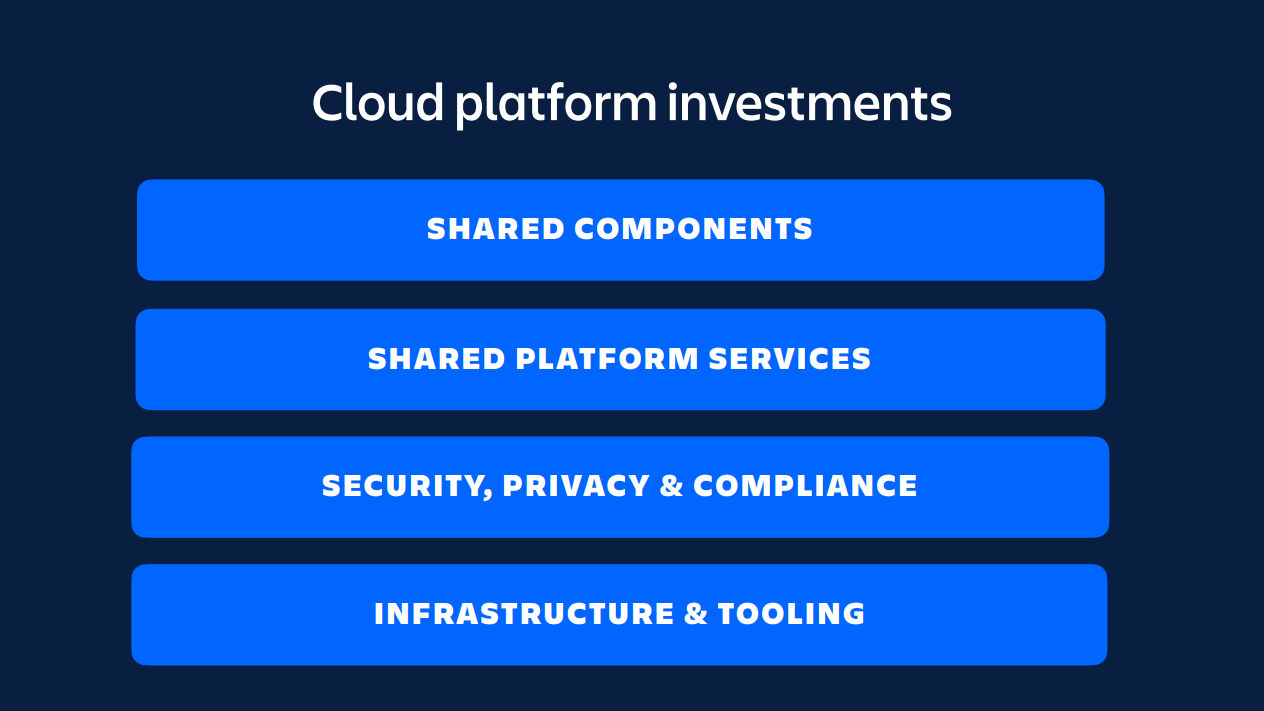
Atlassian solved the commonality challenge (slide 97), by creating platform components and services which spans cloud and server products. “Platform”, for Atlassian, covers a wide range of infrastructure areas that are non-product specific. They invest heavily in this “core platform.”
This creates a common framework which they then expose internally and (in part) to 3rd party developers. A developer engagement program helps fuel creation of new apps and extensions. A marketplace - embedded across Atlassian’s platform - helps customers find, pay for, and use these apps.
Most of these apps are “custom fit” solutions which solves specific needs for specific industries that Atlassian would never build.
Marketplace monetization is becoming meaningful
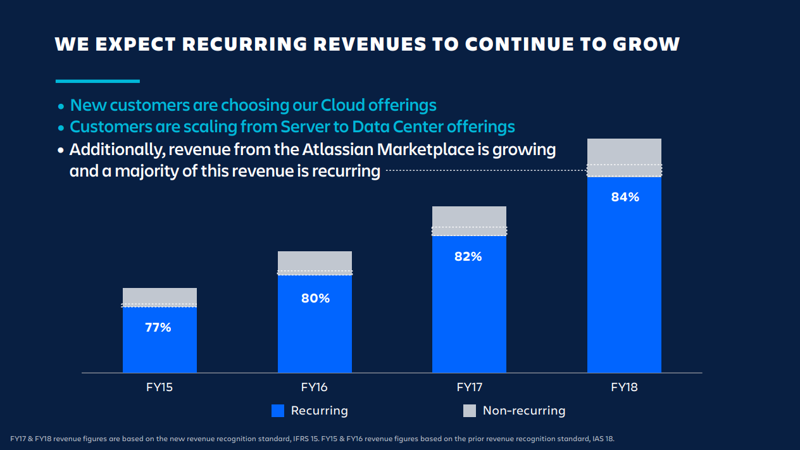
“Back in the day” Atlassian sold the majority of their products on a perpetual license basis. This is similar to buying a Microsoft Windows 95 license once, installing it, and using it forever after without paying again. In theory, sounds great, but in practice customers lose out on updates and new features. There’s a reason we don’t see Windows 95 on office screens anymore…
These days, the majority of Atlassian’s revenue is from their “cloud” offerings - in other words, Software as a Service revenue. They expect this to continue to grow to grow.
They’re also starting to aggregate and count “marketplace recurring revenue” alongside “cloud revenue.” In reality, the stated percentage of 84% cloud/recurring revenue actually really higher than that because the majority of marketplace revenue is also recurring in nature.
Based on the chart, it looks like this marketplace revenue is almost doubling year-on-year. For FY 2018, cumulative marketplace sales could be in the region of a $200M - $250M. As Atlassian retain 25% of this through their marketplace agreement, this likely equates to a meaningful $50M - $62.5M revenue for Atlassian.
The full session is available to watch here and the 155 slide deck is available here.





